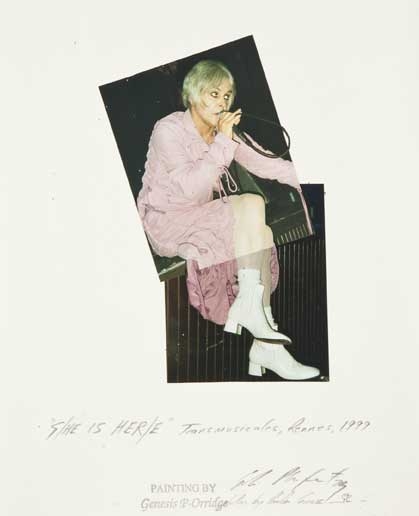A retrospective that spans more than 30 years must inevitably be partial, presenting mere fragments of an oeuvre. For Genesis Breyer P-Orridge, the connective tissue for these severed pieces of a largely collaborative practice, from COUM Transmissions during the 1970s to Lady Jaye Breyer in the 1990s and 2000s, is the ‘cut’.
The slashes of the exhibition title, S/HE IS HER/E, point to the surgical cuts of the artist’s final collaboration with Lady Jaye: submitting themselves to the plastic surgeon’s knife, the two artists undertook a series of surgical procedures and hormone therapies to transform their bodies into mirrors for (or uncanny doubles of ) one another.
Breyer P-Orridge is the name for this merged identity – the pandrogyne ‘third being’, as the artists put it – produced by these corporeal cuts. Following Lady Jaye’s death from cancer in 2007, only Genesis remains as the embodiment of this extreme collaboration. Thus, the twofold gesture of severance and connection seen in S/HE IS HER/E is also an ongoing act of mourning.
Most of the work in the exhibition is collage-based. Aesthetically unremarkable as visual art, it was made largely during the period when P-Orridge was best known in the alternative music scene. But the transgender aspects of the later collage ‘cutups’ are significant as a kind of visual record or documentation of the performative project on identity. This work is neither ironic nor camp: rather, as Genesis puts it in the video The Pandrogyne Manifesto (2003–11), it is a ‘total commitment to the idea not the ideal’. In this sense, it is an utterly sincere avant-gardist undertaking, and the use of the manifesto form, with its desire to realise the apparently impossible, is wholly apropos.
The works from the era of COUM Transmissions, a performance art collaboration that also included among its members Cosey Fanni Tutti and Peter ‘Sleazy’ Christopherson, are few. But they are some of the standout pieces. One in particular, Mum and Dad (1971), is a repeated grid-format arrangement of passport photographs of P-Orridge’s parents. The captions ‘Mum’ and ‘Dad’ are shuffled free from the correct image in a game of gender misnaming. Evocative of surrealist uses of play, this queering of the family structure upends the heterosexual norms of that formative avant-garde precedent.
There is minimal reference to the ground- breaking industrial music group Throbbing Gristle, which formed in 1976 and included the three key members of COUM (together with Chris Carter). With the exception of the emblematic neon Thee Ghost (2010) that viewers face upon entering the exhibition, evidence of the later band Psychic TV (fronted by P-Orridge) is also likewise sparse.
The decision to sideline the music projects in favour of the collage-based visual works makes sense for a museum venue. But the music context is decisive, for the visual work makes most sense as a form of memorabilia marking P-Orridge’s challenge to the commercial ideals of the pop idol and the group identification of the fan.
Andy Warhol Museum, Pittsburgh, 15 June – 15 September 2013. This review originally appeared in the September 2013 issue of ArtReview.
